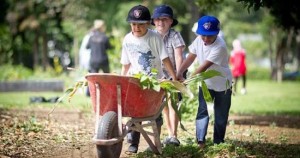 Do you get your 5+ A Day?
Do you get your 5+ A Day?
That’s the minimum number of servings, 2 fruit and 3 vegetables the size of your hand, that we all need each day for better health.
Fruit and vegetables (F&V) are an important source of dietary fibre, vitamins and minerals, trace elements and phytochemicals (especially carotenoids and polyphenols) that help our body to function, grow, replace tissue and prevent damage through inflammation and oxidative stress.1
If taken daily fruits and vegetables can protect our health from problems such as diabetes, cancer, nerve degenerative and cardiovascular disease.1 Healthy dietary patterns that include F&V are also vital in reducing obesity. 2 With 35% of children and 65% of adults in New Zealand now overweight or obese dietary changes can’t come soon enough. 3
It should be easy to follow a healthy Mediterranean style diet in New Zealand where fresh fruit and vegetables are plentiful all year round. However a Ministry of Health survey in 2008 found that only 32% of NZ children meet the 5+A Day guidelines compared to 63% of adults . The children who were particularly affected by low vegetable intake were found to be those from urban dwelling, low socio-economic groups. 4,5
So what will it take to improve our F&V consumption?
Obviously social factors such as income etc are important to the access of F&V for all of us. In the case of children’s F&V consumption studies have shown that it helps to start interventions early as lifestyle habits learned up to the age of 15 years are more likely to be sustainable into adulthood. 5
Understand the barriers to food intake
During childhood children are vulnerable to the influences of others particularly their parents. There is also a complex interplay of other factors such as:
- The childs innate food preferences to the taste, smell, texture, appearance and familiarity of foods
- Food fears, phobias and aversions
- The role modelling from family, caregivers and peers
- Parental interest and knowledge of nutrition, their food preparation and cooking skills
- Environmental factors such as time, cost and availability of food
- Media coverage e.g. television advertising of unhealthy foods
- The availability of convenience and takeaway foods which can compete for the consumption of healthier choices. 5,6
Make fruit and vegetable eating fun
Many adults will have horror stories about being forced to eat their vegetables while they were growing up which may explain while they are less likely to want to eat them now. Parenting styles can always be improved 7 and when trying to change eating behaviours for ourselves and our children it helps if meal times are relaxed and enjoyable and if food preparation is fun.
Grow your own
Even if you lack the space for a vegetable garden you can always grow herbs e.g. parsley, mint and chives or small vegetables such as radishes and baby carrots in flower pots or sacks.
To help children overcome some of their reluctance to eating F&V and to improve nutrition education many pre-schools and schools are now adopting gardening projects and this is happening all around the world 8-12 These projects are reaping surprising benefits for children of all ages e.g.
- A NZ study has found a reduction in body mass index (BMI) and a lower prevalence of overweight children in secondary schools who have participated in garden projects8
- NZ children in year groups 7-8 are learning cooking, recipes and how to increase F&V consumption.9
- Australian children are learning how to identify different F&V and are beginning to change their attitude about food preferences, improving their own consumption of F&V , gaining confidence in preparing F&V and starting to ask for more F&V at home 10
- US Children are enjoying taste testing F&V, gardening and preparing snacks at home 11
- Pre-school children in Missouri have been found to increase their consumption and their preferences for F&V when they were offered home-grown produce that was readily available and also eaten by their parents.12
- The Australian Garden to Table Programmes has linked up with chef Jamie Oliver to promote school gardening around the world and these programmes are also teaching children how to co-operate together as a team, learn life skills and how to gain a greater understanding of the importance of sustainability and the environment.5
Take children shopping
Even very young children can find excitement in fruit and vegetables when adults point out the wide range of different coloured vegetables while shopping e.g.
Red– radishes, kumara,peppers, tomatoes
Orange/yellowcarrots, pumpkin, corn, golden kumara
Brown/whitecauliflower, mushrooms, onions, parsnip, potato
Green– asparagus, beans, brocoli, celery, lettuce
Blue/purple– beetroot, eggplant, purple cabbage 13
Noticing also the different sizes of foods and their countries of origin can add to the experience while encouraging children to count out and weigh foods can aid the development of numeracy skills.
While you are there, pick up any recipe leaflets available for the preparation of unfamiliar F&V and in this way you can learn more too.
Visiting farmers markets and buying from road side stalls when travelling can provide the opportunity to talk to children about farming and food production.
Get creative
If you are looking for play ideas or a craft activity on a wet day encourage your children to make vegetable animals or build a scrap-book by cutting out pictures of F&V. This can also be a great way to teach children the letters of the alphabet.
Get cooking
Encourage children to make simple F&V dishes such as salads, kebabs, vegetable sticks. Teaching them simple food hygiene along the way of washing hands first and using clean utensils and chopping boards etc are all valuable life skills.
Think about your own intake of F&V, your likes and dislikes and don’t be afraid to try new recipes and produce.
Handle fruit and vegetables with care
Starting a garden, shopping and cooking can be fun but if you want fruit and vegetables to be appealing, nutritious and eaten it is important to also retain the goodness of vegetables in the home by handling food with care.
- Wash vegetables well to remove dirt before storing and preparing them
- Use a sharp knife to remove any damaged portions or if cutting during food preparation.
- When storing fruit and vegetables refrigerate fruit (except bananas) green and yellow vegetables, keep root vegetables and onions in a cool dark place. 13
Retain the goodness
Fruit and vegetables are healthier when prepared with minimal processing, fat, salt and sugar. So if possible keep the skins on for more fibre when preparing F&V and avoid juicing them.
Just because a potato is a vegetable it doesn’t mean that a chip is something that children should eat every day. As you can see from the table below the energy from a humble potato can be increased six times when manufactured into a potato chip.
If you are looking for flavouring agents there are a number of alternatives to adding salt. Mashing a potato, with the skins on, with trim milk and whole seed mustard reduces fat and salt while maintaining high flavour and dietary fibre compared to adding butter or sour cream.
Table 1 An energy and nutrient comparison of different preparation methods of potato and fruit.14
| Food (100g) | Energy | Sugars | Fat | Sodium | Dietary fibre |
| kJ/Kcals | g | g | mg | g | |
| Potato,skin on, baked | 354/84.7 | 1.4 | 0.3 | 1.1 | 2.2 |
| Plus butter 10g | 600/143 | 1.3 | 7.8 | 49.1 | 2 |
| or sour cream 10g | 406/97 | 1.5 | 2.3 | 4.3 | 2 |
| or cottage cheese 10g | 358/85.6 | 0.63 | 1.4 | 36 | 2 |
| or parsley, 10g | 337/80.5 | 1.34 | 0.36 | 4 | 2.4 |
| Mashed potato with mustard 1/2tsp+ trim milk 1tb | 367/87 | 2 | 1.3 | 8.2 | 2 |
| Wedges, spiced, KFC® | 826/197 | 0 | 6.5 | 370 | 3.1 |
| French fries, straight cut | 820/195 | 0.56 | 6.2 | 145 | 4.7 |
| Crinkle cut fries | 1005/240 | 0 | 11.8 | 375 | 2 |
| Shoe string chips, mcDonald’s® | 1405/335 | 0 | 18 | 430 | 4.2 |
| Crisps,plain | 2135/515 | 0.5 | 32 | 638 | 3.6 |
| Crisps, salt & vinegar | 2215/529 | 0.6 | 34.6 | 940 | 3.6 |
| Peach fresh | 165/39 | 7.9 | 0.1 | 0 | 1.8 |
| Peaches canned in syrup, drained | 243/58 | 82.5 | 0.1 | 3 | 1.5 |
It’s never to late to start eating more fruit and vegetables and if you would like help to assess and improve the adequacy of your current intake (or that of a family member) then contact us today.
For more information read Lea’s articles:
Tune into your parenting style
Grandparents can help combat obesity
Boosting fibre intake offers health benefits
Organic food market gains traction
Juice diets are they as healthy as you might think?
“Free foods” for hungry children
Summer fruit warning
Fresh verses frozen
Valuable websites for more information
Kidspot Gardening for kids http://www.kidspot.co.nz/kids-activities-and-games/Gardening-for-kids+31.htm
5+ A Day http://www.5aday.co.nz
Fruit in schools https://www.health.govt.nz/system/files/documents/publications/fruit-in-schools-how-to-guide-may06.pdf
Garden to table programmes http://www.gardentotable.org.nz/gtt-in-school-programme
References:
- An updating on antioxidants and F&V consumption IFAVA The Scientific Newsletter No 94 Nov 2014
- Bertoic,M. Rimm,E. Mukamal,K. Hu,F.Willett,W. Cassidy,A. Dietary flavoanoid intake and weight maintainence: 3 prospective cohorts of 124,086 US men and women followed up to 24 years. BMJ 2016:352,i17
- MOH Obesity statistics and data 2014/15 http://www.health.govt.nz/nz-health-statistics/health-statistics-and-data-sets/obesity-data-and-stats
- MOH 2008 survey http://www.health.govt.nz/publication/national-survey-children-and-young-peoples-physical-activity-and-dietary-behaviours-new-zealand-2008
- Wakefield, G. Can the Garden to Table Programme improve children’s fruit and vegetable consumption? 2013 Thesis Mro.massey.ac.nz
- Krølner, R, Rasmussen,M. Brug, J. Klepp, K I, Marianne Wind M, and Due,P. Determinants of fruit and vegetable consumption among children and adolescents: a review of the literature. Part II: qualitative studies Int J Behav Nutr Phys Act. 2011; 8: 112.
- Coleroso B Kids are worth it Harper Collins USA
- Utter, J. Denny, S. Dyson, B. School gardens and adolescent nutrition and BMI: Results from a national, multilevel study . Prev Med. 2016 Feb;83:1-4.
- Collins, C. Richards, R. Reeder, AI. Gray, AR. Food for thought: edible gardens in New Zealand primary and secondary schools.Health Promot J Austr. 2015 Apr;26(1):70-3.
- Somerset S1, Markwell K. Impact of a school-based food garden on attitudes and identification skills regarding vegetables and fruit: a 12-month intervention trial. Public Health Nutr. 2009 Feb;12(2):214-21
- Heim S1, Stang J, Ireland M. A garden pilot project enhances fruit and vegetable consumption among children. J Am Diet Assoc. 2009 Jul;109(7):1220-6
- Nanney MS, Johnson S, Elliott M, Haire-Joshu D. Frequency of eating homegrown produce is associated with higher intake among parents and their preschool-aged children in rural Missouri. J Am Diet Assoc. 2007 Apr;107(4):577-84.
- Gourley,G. The NZ Vegetable Book. Horticulture NZ hortnz.co.nz
- Food Works 8 2015.























































Leave a Reply